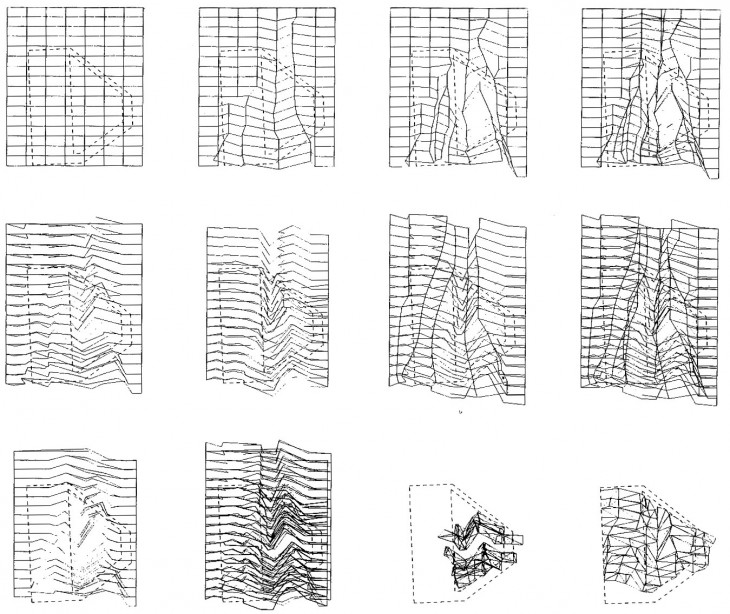Peter Eisenman – Church of the Year 2000
[The] classical scripting of musical notes _ stave _ grid _ process
The reading starts with an interesting comparison of two primitive typologies of shelter. This reference to the instinctive necessity of sheltering, somehow takes the reader to the beginning – the raison d’être of the discipline of architecture. The geographical positioning, the typology, the morphology, the construction method and the organisational layout of the concept of a shelter have been progressively changing, perhaps evolving, since the existence of the human race. This primitive demand for sheltering still is present today, and will probably always be present in the future. Thanks to the reassurance of the presence of this demand, concerned individuals – in this case architects, keep on discussing, critiquing, developing and improving the various features of the past, present and future shelters. (The features being the stated geo-positioning, typo-morphology, method, layout…) The author criticises the modernist approach through a computer science simile of 0s and 1s, arguing that the perfectly functional “nests” of the modernist era as lacking the gradient between the two, in other words, the opportunity and the space for creativity and unexpected encounters, if to quote, “accidents”. While this argument adverts to a prominent issue of the recent past of our built environment, the author renders this insufficiency of the modernist model by objecting to Van der Rohe’s musical description of architecture as the staves. An image of music notes hanging in air without the staves is defended to be as – or even more, coherent (by effacing the main elements of the classical scripting of musical notes), yet rigid numeric ordering and hierarchic titling is used for the organisation of the text. Even though the (post…) post-postmodernist architecture seems to be the anarchist, it actually is the rebellious child of the previous modernists, and like every child, has had a lot to learn from the progenitors.
Although the real meaning of the word “nest” comes to mean a shelter built by birds, when correlated to the word cave, takes a “manmade” implication, where the cave is interpreted as an already existing geographical formation occupied by men. With the introduction of the word “locale” the text goes more into detail about the impact of the occupant and his objects, highlighting the opportunity of these notions to identify the space. With the phrase “manipulated nature” the author defines the garden, which could also have been an interesting “in-between” description of the previously mentioned titles of the cave and the locale. Following the reference, it is important to underline that the occupants have had manipulated the existing – the cave, in order to turn it into their locale. It does not seem correct to conceive the cave as a gift of mother nature for human beings to shelter and seek for opportunities, but more as a space for the occupant to manipulate (through objects, mural artwork, as well as preliminary constructional interior design) and create opportunities through its potentiality.
By the time most of the individuals reach the age to leave the “nest”, they tend to look for a suitable (un-)built environment to find shelter, directed by their individual wills and conditions. This search, just as stated further in the reading, can take the form of a town or a city, a neighbourhood, a street, a house, a room, a bed… Opposing to the inflexible definitions of architectural entities by the modernist – or the “ordinary”, the author gives the reader a different perspective by redefining the part/whole – house/city relationship from a scaleless point of view. The rigid boundaries of a house and a city are questioned, bringing into attention the concepts of inside out – outside in. The Wall House analysed during the previous week of the course is potentially a good example for the practice of this vision. Multiple layers of the skin providing a “delicate” passage from the interior to the exterior (alongside of their sophisticated environmental gains) creating new experiences on how to inhabit the house as well as the landscape surrounding it.
Ruins are defined as “the end” and “the simultaneous beginning” of architecture, putting forward the parameter of time. At this point, the part about the exterior envelopes and how they intercede the relationship with the physical world, brings up an absorbing question of how in the future, architecture could succeed to be the medium between our fast-growing virtual world and our indispensable physical world.
Mehmet Yilmaz Akdogan

